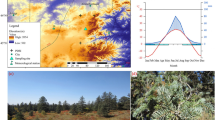Abstract
The effects of dehydration and rehydration on carbon exchange in 14 bryophytes from the maritime Antarctic were investigated using an infra-red gas analysis system. Continuous long-term (1–12 months) and repeated (1–6 one-month cycles) desiccation responses were investigated under controlled conditions. Loss of photosynthetic rate increased with length of dehydration period in all species, although some desiccation tolerance was observed even in those bryophytes from the most hydric habitats. Percentage retention of photosynthetic rate increased from hydric to xeric species, but this pattern was not repeated in terms of absolute rates of carbon fixation due to the high initial rates in the hydric species. Repeated cycles caused a greater loss of photosynthetic rate than continuous dehydration in hydric species, but the opposite situation occurred in mesic and xeric mosses. The latter groups were possibly better able to utilise the short periods of rehydration during cycles. In most bryophytes an increase in the percentage loss of photosynthetic rate following dehydration-rehydration occurred from spring to summer to autumn samples. This pattern was clearest in the hydric species and reduced in the xeric species. These variations were largely due to changes in the initial rates of photosynthesis during the growing season. It is suggested that this increased photosynthetic capacity is stress-sensitive, and is lost during either desiccation or winter freezing; the base photosynthetic capacity, being stress-tolerant, survives either of these events. The results obtained support the hypothesis that water availability is of importance in determining the distribution of bryophytes in the Antarctic. However, only the broad scale of variation in plant communities could be explained by these observations; other factors must be important in determining the finer scale of species distribution and community composition. The results are applicable to attempts to model the productivity of Antarctic bryophytes from known or predicted environmental data.
Similar content being viewed by others
Author information
Authors and Affiliations
Additional information
Received: 15 April 1996 / Accepted: 28 September 1996
Rights and permissions
About this article
Cite this article
Davey, M. Effects of continuous and repeated dehydration on carbon fixation by bryophytes from the maritime Antarctic. Oecologia 110, 25–31 (1997). https://doi.org/10.1007/s004420050129
Issue Date:
DOI: https://doi.org/10.1007/s004420050129




